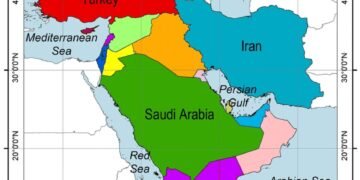“Editor-in-Chief: SHAPOUR-T”
Mir-Hossein Mousavi, Iran’s wartime prime minister and a key architect of the Islamic Republic’s early years, has undergone one of the most perplexing political transformations in the country’s modern history. Once a loyal enforcer of Khomeini’s vision of Islamic governance, Mousavi has, in recent years, positioned himself as a critic of authoritarianism—raising the eyebrows of both reformists and secularists alike.
At the center of this paradox lies a controversial quote attributed to him:
“Cyrus and Darius were invented for us so they could take Islam from us.”
Whether accurately cited or not, the statement encapsulates a deep-seated distrust toward Iran’s pre-Islamic heritage, a view widely held among the ideologues of the 1980s Islamic Republic—of which Mousavi was a pillar.
The Architect of Islamization: Mousavi in the 1980s
As prime minister throughout the Iran-Iraq War (1981–1989), Mousavi helped lay the foundations of an ideologically rigid, state-controlled society. Under his watch, the Islamic Republic expanded its grip on education, media, economy, and the judiciary. Any vestiges of Iran’s ancient past—icons like Cyrus the Great or Zoroastrian symbols—were deemed un-Islamic or even “imperialist fabrications.”
This was not merely rhetoric. Schoolbooks were rewritten, pre-Islamic holidays suppressed, and national identity systematically reframed within a Shiite-Islamist framework. Mousavi never publicly opposed any of this. In fact, he was an active participant.
A Change of Heart? Or Political Rebranding?
Since the 2009 Green Movement, however, Mousavi has attempted to reinvent himself. Placed under house arrest for over a decade, he has released statements critical of clerical overreach, the power of the Revolutionary Guards, and the erosion of civil liberties. His recent calls for “referendums” and “fundamental political reform” have drawn attention.
Still, many remain skeptical. While Mousavi has distanced himself from Supreme Leader Ali Khamenei’s absolutism, he has yet to clearly disavow the Islamic Republic itself—or his own role in shaping its most repressive era. More importantly for secular critics, he has never offered a full reckoning of the 1980s: a decade that saw mass executions, censorship, and the erasure of Iran’s ancient, non-Islamic identity.
Not the Hero Secularists Are Looking For
Among those who seek a post-Islamic Iran, Mousavi remains an uncomfortable figure. His refusal to acknowledge the crimes of the Islamic Republic’s formative years—and his failure to defend Iran’s pre-Islamic cultural heritage—undermines his credibility.
For many secular Iranians, especially the younger generation, Mousavi is not a reformer or a revolutionary figure for the future. He is a product of the very system they seek to dismantle. His recent critiques, however welcome, are seen more as a reaction to personal sidelining than a genuine ideological shift.
Conclusion: Symbol of Contradiction, Not Transition
Mousavi is best understood not as a solution but as a symptom of Iran’s political dilemma. He embodies the contradictions of a generation that helped build the Islamic Republic—only to be devoured by its own logic of control and exclusion. While his dissent may have symbolic value, it does not absolve his role in Islamizing Iran or erasing its ancient identity.
For critics of political Islam, the search for new leadership must go beyond figures like Mousavi—who, in the end, remain too entangled in the past to lead Iran into a truly post-Islamist future.

 English
English







































